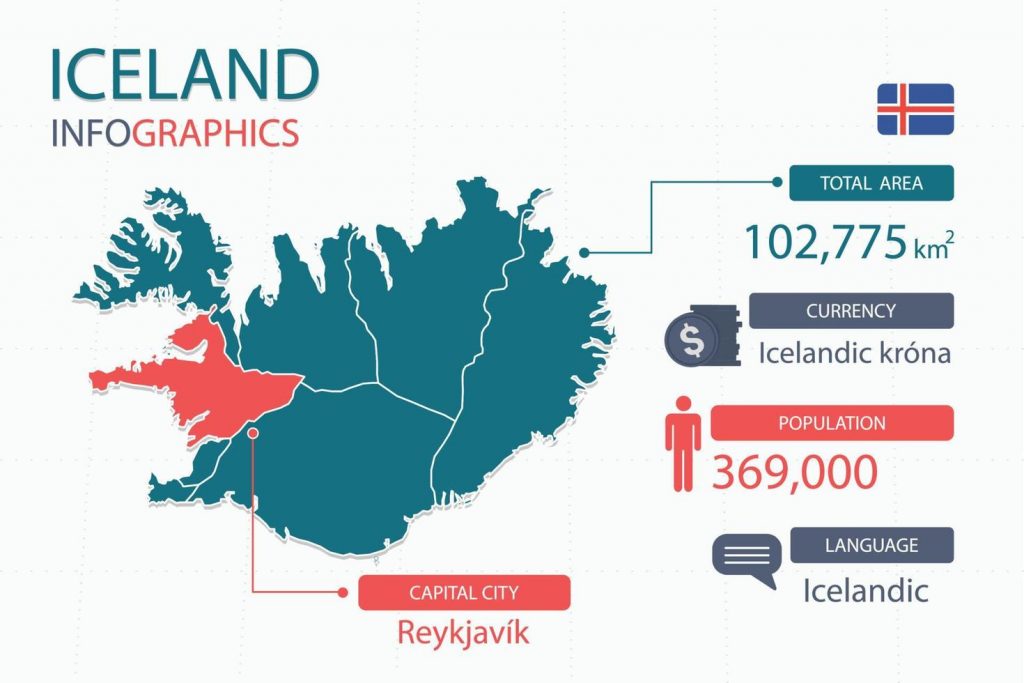The origins of the Icelandic Language
Icelandic is the official language of Iceland. It is a Germanic language, and more specifically, a West Scandinavian language. About 358,000 speakers claim it as their native language. Other languages that are in the West Scandinavian group include all the languages associated with Old Norse: Faroese, Norn, and Western Norwegian. Of course, belonging to the larger family group of Germanic languages, it is also related to English even though this may not be as apparent during modern times.
Icelandic has many similarities to Old Norse, so much so that modern speakers of Icelandic can read Old Norse literary works. Grammatically, Icelandic has a case system that is similar to German. It is also a very heavily inflected language, meaning that verb forms are conjugated for tense, mood, case, and more. In addition, nouns, adjectives, and pronouns also change depending on case and singular and plural. Its basic word order subject-verb-object, but due to the way word forms change to indicate meaning, the word order is rather flexible. However, the verb usually appears in the second position, similar to languages like German.
Icelandic rich vocabulary draws from a variety of sources. Of course, with Old Norse as its basis, a large amount of Icelandic vocabulary has stemmed from it, which is why Icelandic speakers can read Old Norse texts. With the introduction of Christianity, much vocabulary pertaining to religious concepts were taken from other Scandinavian languages, which were more readily used to spread religious ideas at the time of Christianity’s inception in the region. Other sources of vocabulary include French, dialects of German, and of course due to the globalization, English. However, because of a history of language purism, especially in the 18th-19th centuries, many writers and linguists at the time coined new words in an attempt to remove foreign words that entered the Icelandic vocabulary. Such coinage remains a common practice even today, with many public policies and institutions supporting it. The basis of the new words, of course, comes from its Old Norse roots, with academics taking roots, suffixes, and words, and combining them to make new terminology.

Icelandic is written using the Latin script. This script was standardized and established around the 19th century, but was based on earlier documentation found in the 12th century. In addition to the standard set, there are letters that are duplicated but with an additional accent or mark to indicate a different sound; these are considered separate letters. In total, the Icelandic alphabet is comprised of 32 letters. Like most languages that use the Latin script, Icelandic is written from left-to-right.
Most linguists place the beginning of the Icelandic language somewhere in the 9th century. It was at this time that Iceland was settled by Norwegians who spoke a variety of Old Norse. This explains the similarities between Old Norse and modern standard Icelandic. They show such a similarity that some linguists refer to Old Norse as Old Icelandic, even though Old Norse gave birth to other languages as well.
The oldest texts discovered were around the 12th century, and they represent mostly poems and laws that previously had been passed down generationally through an oral tradition. The 12th century, however, saw their codification into writing. Works like the Icelandic Sagas, eddaic poems, and works by Snorri Sturluson are representative of the written work at this time. During this early period, Icelandic settlers were still interacting with many other Scandinavian countries in terms of trade and culture, which influenced the development of the language. However, Icelandic is the Scandinavian language that is the most ‘conservative’, in the sense that it has not changed as much compared to the others. Even though Icelandic took on distinct characteristics, it was still considered a Scandinavian dialect at this time.
The period between 1350 and 1550 is what linguists term Middle Icelandic. Political changes influenced the language at this time. For example, the Danish crown occupied Norway and other areas, which therefore led to different linguistic development patterns for those speech communities. On the other hand, Icelandic was less influenced. While the other Scandinavian dialects were quite influenced in its development by Danish, Icelandic remained relatively unaltered, most notably in terms of grammar. The changes that Icelandic underwent at this time came from more internal influences from within the Icelandic speech community and the dialects that they employed. These dialects influenced each other, which affected grammar and vocabulary.
Modern Icelandic can be said to have emerged around 1550 due to two important factors. First, there was the introduction of the printing press, which allowed a standard Icelandic to spread across Iceland. This new invention, combined with the Lutheran Reformation, during which there was a translation of the Bible from Latin to local languages, helped standardize the language used vernacularly as well. With a religious motivation and the power of the press, Icelandic became more uniform. In comparison to other languages, still, the language retained a very conservative characteristic. The writing system did not change as much and the grammar retains features that have been present dating back to Old Norse. Moreover, in comparison to other languages, not that many loanwords have entered the language, as mentioned above. As an example of its conservatism, while the writing system was developed in the 19th century, it was based heavily on conventions in the 12th century.
Further cementing its conservatism against linguistic change, the Icelandic administration made sure to implement policies to protect the language from a change from the 18th century on. The policies gave responsibility to professional terminologists to coin new vocabulary so that Icelandic can express new concepts. This new vocabulary draws from Old Icelandic, i.e. Old Norse, roots, combining suffixes and prefixes to create words related to science and technology. Thus, while Icelandic has had influences from other languages, its effect has been minimal.
In current times, Icelandic has been the official language of Iceland since 2011. Linguistic purism is advocated and maintained by the government and many administrative and social institutions such as the Icelandic Language Council, as well as the Icelandic Language Fund. Thus, the community of Icelandic speakers views its language as an integral part of their national identity. With such an effort, Icelandic has also maintained a rich literary history dating back to Old Norse and is used in all forms of media.
VEQTA can provide you with a perfect Icelandic translator for your Icelandic translation, English to Icelandic translation and Icelandic to english translation for the your targeted locale. Our translations to Icelandic are created with your target audience in mind to meet your expectations.
If you need to translate Icelandic – Get in touch today!
A dedicated team of Icelandic translators who combines Experience, Specialized Subject Matter Expertise with best Translation Practices to deliver quality second to none.
Icelandic Subject Expertise
Icelandic Translators
Icelandic Editors
Icelandic Copywriters
Icelandic Reviewers
Icelandic Voice dubbing
Icelandic Subtitling
Icelandic Transcription


